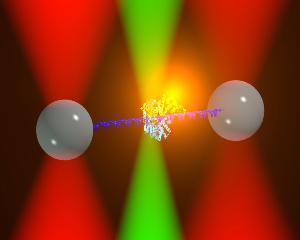Illinois researchers have combined two molecular imaging technologies to create an instrument with incredible sensitivity that provides new, detailed insight into dynamic molecular processes.
Physics professors Taekjip Ha and Yann Chemla and combined their expertise in single-molecule biophysics – fluorescence microscopy and optical traps, respectively – to study binding and unbinding of individual DNA segments to a larger strand. They and their joint postdoctoral researcher Matthew Comstock detail their technique in a paper published in the Feb. 20 online edition of Nature Methods.
 Illinois researchers developed a new technique that combines optical traps (red) with fluorescence (green) to study the proteins that regulate DNA.
Illinois researchers developed a new technique that combines optical traps (red) with fluorescence (green) to study the proteins that regulate DNA.
Both professors have particularly studied proteins and enzymes that regulate DNA, such as the enzyme helicase that unwinds DNA for duplication or transcription to RNA. Fluorescent microscopy techniques allow researchers to observe proteins as they conform and move, but often lack the spatial range to track the protein's motion over distance.
Optical traps, meanwhile, enable researchers to study a protein's translocation, but not its conformation. Chemla compares traditional optical traps to fishing. A single molecule of DNA is tethered between two attachment points, and the activity of a protein bound to it is only inferred from how it tugs on the tether, much like a fish at the end of a line. This can reveal a lot about a protein's activity and motion, but the technique has glaring limitations as well. For example, it is difficult to know how many proteins or the types of proteins that are involved.
"Also, these proteins may do all sorts of things beyond tugging on our line that we may not be sensitive to," Chemla said. "Fluorescence allows you to have an additional readout to actually see these things, and the key is that we can now measure them simultaneously. This work was a real synthesis of the expertise of two groups at the Center for the Physics of Living Cells at the U. of I."
The combination allows Chemla, Ha and their group to measure both a protein's motion – sensitive to translocation as small as one DNA base pair, a distance of only a few angstroms – and also conformational changes as it acts. This can reveal details about its mechanism that would not have been accessible before.
"It was a major technical challenge, but the final product is a one-of-a-kind instrument with unique capabilities," Chemla said. "It's like taking a rudimentary, real-time 'movie' of what individual molecules are doing."
Source: http://www.uiuc.edu/